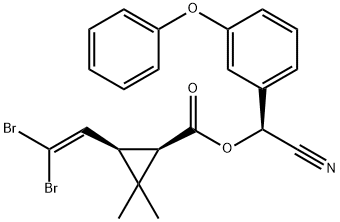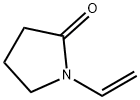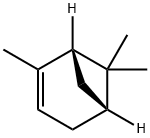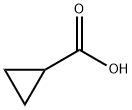DeltamethrinSolutioninAcetonitrile , 100μg/mLinAcetonitrile,uncertainty3%
Synonym(s):
(S)-α-Cyano-3-phenoxybenzyl(1R)- cis-3-(2,2-dibromovinyl)-2,2-dimethylcyclopropanecarboxylate;(S)-α-Cyano-3-phenoxybenzyl(1R)-cis-3-(2,2-dibromovinyl)-2,2-dimethylcyclopropanecarboxylate;Deltamethrin - CAS 52918-63-5 - Calbiochem
CAS NO.:
Empirical Formula: C22H19Br2NO3
Molecular Weight: 505.2
MDL number: MFCD00870122
EINECS: 258-256-6
| Pack Size | Price | Stock | Quantity |
| 1.2ml | RMB71.20 | In Stock |
|
| others | Enquire |
PRODUCT Properties
| Melting point: | 98°C |
| Boiling point: | 300°C |
| alpha | +56~+64°(20℃/D)(c=4,C6H6) |
| Density | 1.5214 (rough estimate) |
| vapor pressure | 1.24×10-2Pa (25 °C) |
| refractive index | 1.6220 (estimate) |
| Flash point: | -18 °C |
| storage temp. | −20°C |
| solubility | Soluble in DMSO (up to 50 mg/ml) |
| Water Solubility | <0.0002 mg l-1 (25 °C) |
| form | Crystalline |
| color | Colorless |
| λmax | 278nm(Hexane)(lit.) |
| Merck | 14,2883 |
| BRN | 6746312 |
| Stability: | Stable. Incompatible with acids, alkalies, strong oxidizing agents. |
| LogP | 6.200 |
| IARC | 3 (Vol. 53) 1991 |
| NIST Chemistry Reference | Deltamethrin(52918-63-5) |
| EPA Substance Registry System | Deltamethrin (52918-63-5) |
Description and Uses
Deltamethrin is a type II pyrethroid insecticide and a modulator of voltage-gated sodium channels (Nav). It binds to Drosophila para Nav channels in a use-dependent manner following brief depolarizing prepulses and with increasing concentrations of 1 to 5 nM, indicating that it preferentially binds to the channel in the open state. It slowly activates Nav1.8 channels, delays inactivation by longer than 40 ms, and induces persistent tail currents for channels expressed in X. laevis oocytes. Deltamethrin decreases proliferation of MCF-7 cells and inhibits androgen receptor transactivation when used at concentrations of 10 and 20 μM or greater, respectively. However, it is not cytotoxic to MCF-7 and CHO cells at concentrations of 25 and 100 μM, respectively, and does not induce transactivation of the estrogen receptor. Deltamethrin is lethal to mice with an LD50 value of 50 mg/kg and at low sublethal doses of 0.05 and 0.1 mg/kg it induces histopathological changes in the liver, kidney, spleen, and testes, including a loss of spermatozoa and Sertoli cells.
A Type II pyrethroid insecticide that potently inhibits calcineurin
Safety
| Symbol(GHS) |   GHS06,GHS09 |
| Signal word | Danger |
| Hazard statements | H301+H331-H410 |
| Precautionary statements | P261-P264-P270-P273-P301+P310-P304+P340+P311 |
| Hazard Codes | T,N,Xn,F |
| Risk Statements | 23/25-50/53-67-65-38-11 |
| Safety Statements | 24-28-36/37/39-38-45-60-61-62-16 |
| RIDADR | UN 2811 6.1/PG 2 |
| WGK Germany | 3 |
| RTECS | GZ1233000 |
| HazardClass | 6.1(a) |
| PackingGroup | II |
| HS Code | 29269090 |
| Hazardous Substances Data | 52918-63-5(Hazardous Substances Data) |
| Toxicity | LD50 in female rats (mg/kg): 31 orally; 4 i.v. (Kavlock) |





